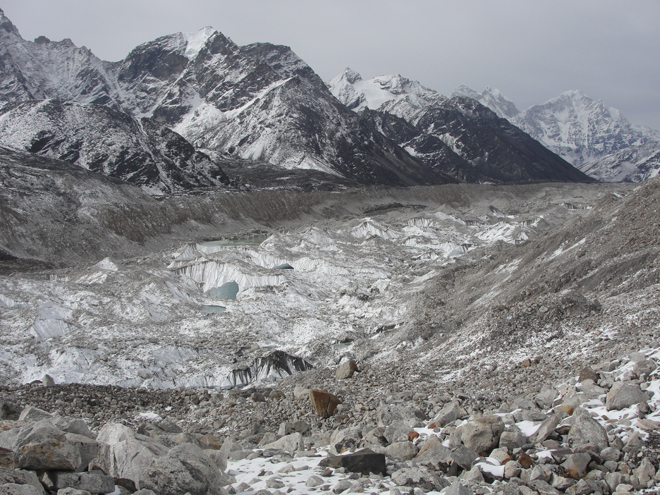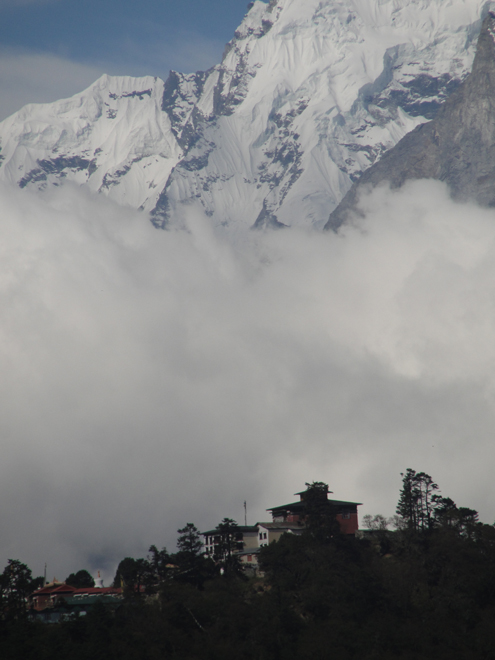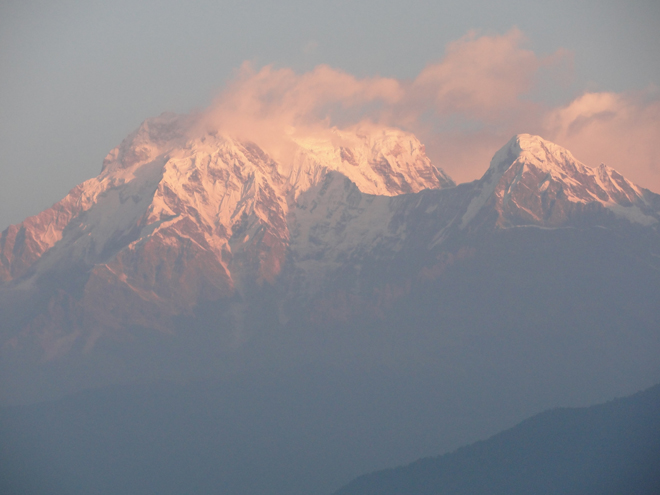 Photo by Michael Restivo
Photo by Michael RestivoBecause the range stands in a historically isolated part of the world, the exploration of the Himalayas, whose name means snow dwelling in Urdu, didn't fully take place until the British began to sojourn north from their territory in India. With explorers returning home with fascinating tales from Nepal and Tibet, autonomous countries sealed from the rest of the world, the public fascination with the East began to grow, and amateur climbers began to launch daring expeditions to climb these unknown peaks. In England, the desire for exploration reached a fever pitch with James Hilton's novel Shangri-La which described a near-utopian society filled with mysticism and wonder. The sensation of the novel provoked a fascination with Tibetan and Himalayan culture.
The chain stretches from Eastern Pakistan to Northwestern Myanmar. While most are familiar with the Great Himalayan Range, topped by its iconic 8,000-meter peaks, it is one of seven sections, including the Karakoram, the Pir Panjal, and the Zanskar. Each individual range is steeped in its own culture, traditions and people. The Sherpas are the most famous for their legendary exploits, however the mountains are essential to the spiritual and daily lives of Pakistani tribesmen and holy men of Northern India. In Buddhist, Muslim, and Hindu tradition, the mountains are the home of the gods and serve as the upper tributaries for three of the world's most important rivers: The Ganges, Indus, and Brahmaputra. These waters support over half a billion people.
Trekking the Himalayas is more than a journey - It's an immersive cultural experience. From the moment adventurers step off the plane at Lukla, an airport where the runway famously careens off the side of a cliff, travelers find themselves enchanted by Sherpa communities, monasteries, dangling wooden suspension bridges, and the swaying of colorful prayer flags. The magic of the landscape isn't only in the mountains, but in the diversity of the biomes. While the mountains undoubtedly define the landscape, it continues into in the lush foothills of Northern India, and the arid desert of the Tibetan Plateau. While thousands of trekkers head to Everest and Annapurna every year, many fewer traverse the icy glaciers of the Karakoram, or the verdant fields of the Langtang Valley.
While the entire range has been documented in song, written word, and camera lens, there are some areas that still remain restricted. The Mustang region of Northern Nepal, for example, has remained shrouded from the throngs of Western tourists. Because of its strict restriction, Upper Mustang retains its strong Tibetan history and language. Only 2,000 people each year are allowed to trek its ancient villages and arid landscape, where white washed mud brick homes, strong Buddhist values, create an atmosphere barely touched by the outside world.
While many consider trekking in the Himalayas to be a daunting endeavor, the trails are not technically difficult in some sections. The biggest challenge is the high altitude and the wide spaces with challenging route finding. A trip to Mt. Everest Base Camp must be planned out carefully, with flexibility given to altitude acclimatization days and the possibility of being stopped for some time because of sudden changes in weather. The trail traverses a sub-alpine desert, glacial moraines, and areas where the path may not always be clear.
The majority of travelers who tread through the mountains opt to reside in teahouses, small family owned Sherpa lodges with basic rooms and amenities. While the more adventurous trekkers pack a tent, the teahouses are warm and inviting hosting travelers from all over the world to a friendly environment. Many use these opportunities not only to socialize, but to find other trekking and climbing partners.
The views from the trail promise to be grandiose and majestic, but not all are difficult to find. One of the most popular beginner trails begins in the lakeside city of Pokhara, and skirts the edge of the Annapurna Range. It culminates in a spectacular morning vista from Poon Hill, a small ridge that rises over the town of Ghorepani. This three-day sojourn travels through colorful farms, quaint villages, terraced fields, and dense rhododendron groves. Ambitious travelers use this opportunity to explore the Annapurna Circuit and Base Camp, while others head to the village of Tatopani to indulge in the natural hot springs.
For aspiring mountaineers, the Himalayas are ripe with peaks that don't require the technical ability of climbing an 8,000-meter objective. While snow and glacial climbs do require prior mountaineering knowledge, summits such as Island Peak and Lobuche East are short yet stout climbs that are well worth the bragging rights of having ascended a Himalayan peak.
The last great objective is the Great Himalaya Trail, a half improvised trek that spans the 4,500-kilometer length of the range from Pakistan to Bhutan. The entire trail links five distinct sections across all countries, including potentially tricky forays into Tibet. While the Nepal and Indian sections have been crossed, the extension of the Karakoram remains the last challenge of a full Himalayan traverse.
On an early morning, a plane lifts off the concrete tarmac at Lukla and veers south, bound for Kathmandu and the end of an adventure into one of the most remote, wild, and highest landscapes on Earth. As the mid-morning sun bathes the interior in a delicate gold light and the small Twin Otter begins to turn, glaciated pyramids piece the dawn sky, overshadowed by a gray monolithic point - the tallest peak on Earth. With the soft alpenglow, the mountains appear to almost smile, rewarding climbers and trekkers with humbleness and reverence for this spiritual land.








